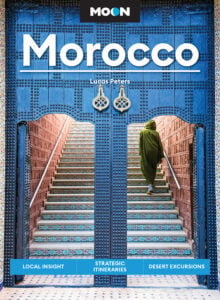Essaouira, formerly known as Mogador, boasts a history as vibrant as its striking blue and white architecture. This coastal jewel has witnessed civilizations come and go, each leaving their mark on its character. With a wide array of cultures and experiences in a very human-sized city, today’s Essaouira has a well deserved place on the list of UNESCO World Heritage Sites.
A Brief History of Essaouira
Essaouira’s history stretches back at least 2,000 years. There is ample evidence than Essaouira was inhabited in prehistoric times, but it’s first modern mention was in the 5th century BC, when the Carthaginian’s first established a trading post. The post was expanded 400 years later by King Juba II who made use of the indigenous sea snail population to make Tyrian Purple. This was a great source of wealth at the time.

Its strategic location on the Atlantic coast attracted explorers like the Portuguese, who briefly held sway over the city in the 16th century. They christened it Mogador, a name still occasionally used today. The iconic ramparts of the old city of Essaouira date from this period. The city would, over the years, be fought over and at one point, even become a haven for pirates.
In the 18th century, Sultan Mohammed III envisioned a grand port city to establish Morocco’s maritime presence and foster trade with Europe. He summoned French engineer Théodore Cornut and Ahmed al-Inglizi and fortified the city with groundbreaking design elements, using French slaves gained from a failed attempt by France to take Larache.
The UNESCO World Heritage of Essaouira
Essaouira earned its UNESCO World Heritage status in 2001 for its innovative blend of European military architecture and Moroccan aesthetics. In fact, once inside the fortress walls, you will likely notice more in common with similar fortified port towns found in France than others in Morocco. Part of this has to do with the engineer Théodore Cornut who was greatly influenced by another French engineer known as Vauban who lived in Saint Malo.

Because of the extraordinarily well-preserved city within the fortress walls, as well as the fortress walls themselves, and the historical importance of the city serving as the primary port linking trade over the Sahara with the rest of the world, it is no wonder that Essaouira finds itself in the company of other standout UNESCO World Heritage Sites found throughout Morocco.
UNESCO World Heritage Sights to Visit in Essaouira
Medina of Essaouira
The historic old city, or “medina,” of Essaouira is a well-preserved example of late 18th-century fortified architecture. With its distinctive blue and white buildings, intricately carved doorways, narrow winding streets, and busy markets scented by exotic spices, you can easily spend a day enjoying the town. Keep in mind that the ambiance you find here draws inspiration from many sources, including Berber, Arab, French, and Portuguese.

Skala de la Ville
Perched atop the medina’s northern ramparts, the Skala de la Ville offers a panoramic view of the Atlantic Ocean and the bustling harbor below. This fortress-like structure once served as a defensive bastion against pirate attacks, and its iconic cannon-lined walls now provide an ideal spot for soaking in the coastal vistas. It’s hard to take a walk along the rows of cannons and not image pirates battling it out over this prized harbor.
Mogador Island
Mogador Island is for the birds. Quite literally. This is an ecological sanctuary that enhances Essaouira’s UNESCO World Heritage status. This uninhabited island, located just off the coast, is a haven for local and migratory birds as well as marine life. Visiting the island is discouraged as you wouldn’t want to disturb the local population. It might be interesting to know though that on this island is where it is thought Juba II and his people first discovered the sea snails that made the Tyrian Purple.
Argan Forests

Essaouira’s UNESCO recognition extends to the unique ecosystems of its surrounding argan forests. These forests are home to the argan tree, believed to be indigenous to the southwestern region of Morocco. The argan tree produces valuable argan oil, often referred to as “liquid gold.” The traditional process of harvesting and extracting argan oil, involving goats climbing the trees to first eat the argan fruit, is deeply ingrained in the local culture. Visitors can witness this age-old practice while supporting sustainable livelihoods for the communities.
Essaouira’s Jewish History
Jewish presence in the Essaouira region dates back at least to the 15th century, during the reign of the Wattasid dynasty, though likely there was a population who lived here long before.
In the 15th century, Jewish traders and merchants were attracted to the city due to its strategic coastal location and thriving trade routes. Around the 18th century, the Jewish Mellah (quarters) were established in the city and the Jewish community played a significant role in the economic and cultural life of Essaouira. Many Jews were involved in trade, crafts, and various industries. They also maintained close ties with Jewish communities in Europe and other parts of North Africa.
In the mid-20th century, as Morocco gained independence and Essaouira lost its standing as a main trading port in favor of other locations, many Jewish families in Essaouira, like in other parts of Morocco, began to emigrate, primarily to Israel, France, and Canada. This resulted in a significant decline in the Jewish population of the city. This does not mean however that their heritage in the region was not preserved.

These days, visitors can find a couple of synagogues, such as the Simon Attias Synagogue and the Slat Lkahal Synagogue, that have been lovingly restored. Essaouira is also well known in the Jewish community for its hiloula celebrating the holy Rabbi Haïm Pinto. Every year, some 2,000 pilgrims gather to pray, sing, dance and eat. To accommodate many of the pilgrims, kosher hotels are available.
Today, while the Jewish community in Essaouira is much smaller than in its heyday, the city still maintains a cultural and historical connection to its Jewish past. The Mellah area stands as a testament to the city’s diverse and inclusive history.
With its UNESCO World Heritage status, unique argan forests, long sandy beaches, and rich heritage it’s little wonder that many travelers come to Essaouira for a few days only to wind up here for months on end!
And that isn’t even touching on some of the food experiences you can consider while in Essaouira, be it a fashionable food tour or an experience with a local family cooking up some tajines for dinner!
About the Author

Omar is an American-Moroccan who grew up in Washington DC before moving to Morocco, where he has lived in a few different places including Fez, Meknes, Ifrane and Rabat. Omar always keeps one foot in each country and is very comfortable navigating through both cultures. Omar currently lives in Rabat working in the development sector and pens the occasional deep-dive travel article. He helps our travelers at Journey Beyond Travel behind the scenes and occasionally meets them for coffee in his current home town, Rabat.









